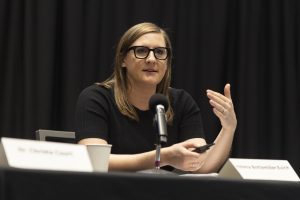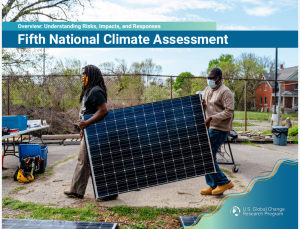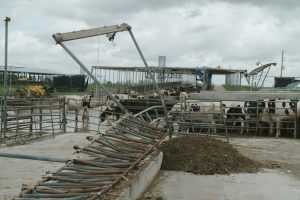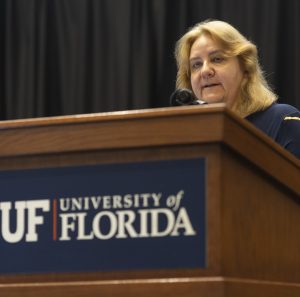Welcome to our new blog post series about the topics covered at the 2024 Future of Food Forum: Resilient Food Systems: Beyond the Rhetoric, the flagship event here, at the Global Food Systems Institute. It was a day to remember, loaded with insights and opinions from experts in the field of food systems, and we want to tell you all about it.
In this series, we will summarize some of the most important messages that our panelists left with us, such as why resilient food systems are important, and what the future of food systems resilience looks like.
We will start with a summary of the first panel of the day: Threats to Food Systems Resilience, moderated by Dr. Lisa House, Professor and Chair, UF/IFAS Food Resource Economics Department. The guest panelists were Helena Bottemiller Evich – Founder and Editor-in-Chief of Food Fix, Dr. Christa Court – Director of the Economic Impact Analysis Program and Assistant Professor at the UF/IFAS Food and Resource Economics Department, and Dr. Sabine Grunwald Professor, Pedometrics Landscape Analysis and GIS at the UF/IFAS Soil and Water Sciences Department.
“How a short-term political culture addresses a long-term challenge. “
Helena Bottemiller Evich – Award-winning reporter who previously led food coverage at Politico, and Founder and Editor-in-Chief of Food Fix.
In this talk, Helena discussed how the current short-term political culture (projects planned for 1 or 2 years) intersects with long-term global challenges, particularly regarding climate change and food resilience.

In her words, Washington, DCs dysfunctional political landscape often presents tricky situations and complex challenges to implementing long-term solutions amidst short-term funding and staff turnover. The lack of long-term vision frequently presents funding issues that disrupt the planning and functioning of federal agencies. Something that affects not only federal workers but also those who rely on federal funding, such as researchers and programs like the Farm Bill and WIC (Women, Infants, and Children program). So how can we address this?
Helena presented the Global Change Research Program (GCP) as an example of long-term planning across multiple federal agencies as a sound strategy to face these challenges. This program, established in 1989 during the presidency of George H.W. Bush (and still running to this day), was created in response to growing concerns about global environmental changes, including climate change.

This program was designed to be operated jointly by 14 different federal agencies, including the USDA, NASA, the Department of Defense, and the Environmental Protection Agency (EPA), creating a decentralized model that ensures that the program is constantly drawing on a diverse range of expertise and resources, making it robust, comprehensive, and very resilient to political changes.
Thanks to this structure, even with administrations that showed efforts to undermine or downplay the GCP, the program has been able to do high-level research and keep publishing the National Climate Assessments (NCAs), a key document that summarizes the latest scientific knowledge about climate change and its impacts on the United States, providing valuable information for policymakers, researchers, and the public.
Helena concluded policymakers and scientists can look to GCP as an example of how to continue work on issues that might be politically controversial. If we develop more long-term, collaborative, and science-based initiatives that can thrive even in a political environment that often prioritizes short-term thinking, we will be able to face the complex and long-term challenges that we are seeing every day.

“Impacts of Natural Disasters on Florida Food Systems”
Dr. Christa Court – Director of the Economic Impact Analysis Program and Assistant Professor at the UF/IFAS Food and Resource Economics Department
For the second talk of the panel, Dr. Court talked about her work on analyzing how natural disasters affect agricultural production in Florida, particularly when talking about hurricanes. The team she leads specializes in regional economic modeling, specifically focusing on economic impact analysis of industrial activity, including agriculture.
When disaster strikes, it is really important to know exactly what happened, where, and how bad was it. Because of the tremendous impact of events like hurricanes, we often see in the news, the millions, or billions of dollars these events caused in losses. But how and by whom are these numbers calculated?
For atmospheric and climate-related data, like storm paths, precipitation levels, and flooding, information is readily available from agencies like the National Weather Service (NWS) or the National Oceanic and Atmospheric Administration (NOAA). However, for specific agricultural losses, the situation is a bit more complex.
In her talk, Dr. Court mentioned that, in order to assess the actual damage of these events, scientists are required to collect information directly from the field to know the extent of the damage as there is currently no way that satellites or other sensors can gather it in a quick and reliable way, especially for diverse agricultural operations. It is also difficult to quantify the impacts because each hurricane (or natural disaster) is unique, as the intensity, trajectory, and time of year change with every occurrence, making standardized data collection even more complex and less reliable.
On the other hand, we have the specific local context of Florida agriculture. The ability to grow a diverse set of crops within the state is a paradise for farmers but it further complicates the data collection process, as the same event can have extremely different impacts based on the local conditions, the local infrastructure, and the specific crops planted in the affected area. Dr. Court said, “If the (impacted area) is a small area but has a really high-value crop on it, that’s going to be just as large of an impact as a large area that has a lower-value crop.”

For data collection, UF/IFAS researchers and extension agents use detailed surveys to estimate the losses. However, they have to apply these surveys to people who were just struck by powerful forces of nature, who, in many cases have lost a lot, if not all their possessions or years’ worth of work, and who are dealing with the aftermath of the disaster. The researchers have to develop surveys that strike a balance between gathering comprehensive information while being aware of the emotional state of the people being interviewed. No one wants to answer a lot of questions just after a hurricane’s impact. They need to capture as much information as possible asking the least amount of questions so that they can let people carry on with their recovery.
Dr. Court’s team concluded by telling us about her team’s work on developing what she calls state-of-the-art agricultural impact tools. With these tools, scientists can acquire some of the information that government officials and decision-makers need in a very short turnover time, significantly improving government agencies’ response times while still being able to reliably assess the impact of the event, even at different time scales (short-term impact vs. long-term impacts).
“Power, Perils, and Myths of Novel Sensor and AI (Artificial Intelligence) Technologies to Boost Soil-Crop Health”
Dr. Sabine Grunwald – Professor and Director of the UF/IFAS Pedometrics, Landscape Analysis, and GIS Laboratory, of the Soil, Water, and Ecosystem Sciences Department.
On the last talk of the panel, Dr. Sabine Grunwald discussed the tremendous challenges related to addressing food and soil security (different but interconnected concepts), amidst a changing climate, a quickly growing population, exacerbated natural disasters, and how technology can help us deal with them.

The first alternative she mentioned was precision agriculture. This is a pivotal agricultural technique that leverages advancements in soil and crop health sensing, nutrient sensing, and the Internet of Things to stabilize crop yields and productivity. Among the most important strategies developed with precision agriculture are drones and field sensing technologies. However, these are strategies that not every farmer can use, and may be particularly difficult for smallholder farmers to access, especially in the global south.
Nonetheless, the advancements in these technologies are allowing real-time soil health monitoring involving multi-sensor systems that use a variety of advanced techniques like diffuse reflectance spectroscopy, electromagnetic induction, and X-ray technology to assess multiple soil properties simultaneously. She mentions that these technologies, used in combination with AI can be extremely powerful, and can be used to characterize the conditions of the whole agro-ecosystem allowing farmers to make highly informed and very specific nutrient and management decisions for their crops.
On the cutting-edge side of things, Dr. Grunwald mentions that nowadays we can even encounter data integration into “data hypercubes” allowing the development of digital twins for soil and crop health and involving advanced AI-driven tools, machine learning, and deep learning technologies. These models can be validated using field and lab data, they are now showing promising results in regions such as Florida and India, and they can even be applied to unsampled locations if spectral instruments are available. This means that you could virtually make appropriate and specific soil and crop management decisions, even if you have not tested the soil in a certain place. This could be a game-changing strategy for the food-insecure regions of the world, as it would allow them to have world-class agricultural techniques, without the need for comprehensive (and expensive) soil testing.

These are all wonderful and powerful strategies, but Dr. Grunwald mentions that there is still a notable digital divide between AI modelers and stakeholders given the disparities in data collection, and access to information, particularly in Africa and Asia, which limit the development and application of global models. Not to mention the, usually necessary, involvement of private corporations in vulnerable regions of the world to apply these technologies, a situation that can potentially raise questions about food sovereignty, data ownership, and access.
Dr. Grunwald closes her talk by mentioning the importance of integrating AI technology with field knowledge and stakeholder input for the successful application of these systems. Awareness and practical application of these technologies can drive significant advancements in agricultural productivity and food security globally, but it needs to be done carefully considering the specific context of every situation.
Thanks for reading! See you at the next GFSI Blog entry.
 2
2

